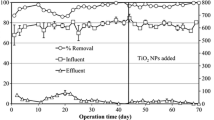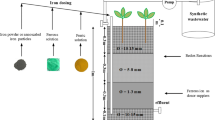Abstract
Titanium dioxide nanoparticles (TiO2 NPs) can potentially impact constructed wetlands (CWs). The aim of this study was to investigate the rapid impacts on nitrogen removal performance and on the microbial community after short-term exposure to TiO2 NPs in CWs, which were determined via 16S rDNA amplicon sequencing and Biolog-Eco technologies. The results showed that removal efficiencies declined by 23.9%, 32.2%, and 38.8% for ammonia nitrogen (NH4+-N) and by 26.5%, 43.4%, and 71.4% for nitrate nitrogen at TiO2 NP concentrations of 50, 100, and 150 mg/L, respectively. Bacterial damage and TiO2 NP agglomeration on the packing increased as the TiO2 NP concentration increased. Microbes showed different tolerances against TiO2 NPs, and members, such as the bacteria removing organic pollutants and NH4+-N, were susceptible to TiO2 NPs. The order of microbial utilisation of the six carbon sources was determined, and the utilisation ratios declined as TiO2 NP concentration increased. The concentration of 50 mg/L TiO2 NPs impaired the functions of nitrifiers and denitrifiers in CWs after short-term exposure, and higher concentrations (100 mg/L and 200 mg/L) had no additional negative impact on the packing compared with the concentration of 50 mg/L.








Similar content being viewed by others
Availability of Data and Materials
All data generated or analysed during this study are included in this published article (and its supplementary information files).
Code Availability
Not applicable.
References
Ahmad, R. Y., Mohammad, R., Hasti, D., & Mohammad, A. A. (2019). Responses of flocculated activated sludge to bimetallic Ag-Fe nanoparticles toxicity: Performance, activity enzymatic, and bacterial community shift. Journal of Hazardous Materials, 366, 114–123. https://doi.org/10.1016/j.jhazmat.2018.11.098
Bates, S. T., Berg-Lyons, D., Caporaso, J. G., Walters, W. A., Knight, R., & Fierer, N. (2011). Examining the global distribution of dominant archaeal populations in soil. ISME Journal, 5, 908–917. https://doi.org/10.1038/ismej.2010.171
Button, M., Cosway, K., Sui, J., & Weber, K. (2019). Impacts and fate of triclosan and sulfamethoxazole in intensified re-circulating vertical flow constructed wetlands. Science of the Total Environment, 649, 1017–1028. https://doi.org/10.1016/j.scitotenv.2018.08.395
Cao, C., Huang, J., Guo, Y., Yan, C., Xiao, J., Ma, Y., Liu, J., & Guan, W. (2019). Long-term effects of environmentally relevant concentration of Ag nanoparticles on the pollutant removal and spatial distribution of silver in constructed wetlands with Cyperus alternifolius and Arundo donax. Environmental Pollution, 252, 931–940. https://doi.org/10.1016/j.envpol.2019.05.144
Chow, K. L., Man, Y. B., Tam, N. F. Y., Liang, Y., & Wong, M. H. (2017). Removal of decabromodiphenyl ether (BDE-209) using a combined system involving TiO2 photocatalysis and wetland plants. Journal of Hazardous Materials, 322, 263–269. https://doi.org/10.1016/j.jhazmat.2016.05.097
Chowdhury, N., Nakhla, G., & Zhu, J. (2008). Load maximization of a liquid–solid circulating fluidized bed bioreactor for nitrogen removal from synthetic municipal wastewater. Chemosphere, 71, 807–815. https://doi.org/10.1016/j.chemosphere.2007.11.070
Clairmont, L. K., Stevens, K. J., & Slawson, R. M. (2019). Site-specific differences in microbial community structure and function within the rhizosphere and rhizoplane of wetland plants is plant species dependent. Rhizosphere, 9, 56–68. https://doi.org/10.1016/j.rhisph.2018.11.006
Davey, L., Halperin, S. A., & Lee, S. F. (2016). Thiol-disulfide exchange in gram-positive firmicutes. Trends in Microbiology, 24, 902–915. https://doi.org/10.1016/j.tim.2016.06.010
García, A., Delgado, L., Torà, J. A., Casals, E., González, E., Puntes, V., Font, X., Carrera, J., & Sánchez, A. (2012). Effect of cerium dioxide, titanium dioxide, silver, and gold nanoparticles on the activity of microbial communities intended in wastewater treatment. Journal of Hazardous Materials, 199–200, 64–72. https://doi.org/10.1016/j.jhazmat.2011.10.057
Ge, Z., Du, H., Gao, Y., & Qiu, W. (2018). Analysis on metabolic functions of stored rice microbial communities by BIOLOG ECO microplates. Frontiers in Microbiology, 9, 1375. https://doi.org/10.3389/fmicb.2018.01375
Hasti, D., Mohammad, R., Ahmad, R. Y., Mohammad, A. A., & Qiu, G. (2019). A comparative study on the toxicity of nano zero valent iron (nZVI) on aerobic granular sludge and flocculent activated sludge: Reactor performance, microbial behavior, and mechanism of toxicity. Process Safety and Environmental Protection, 129, 238–248. https://doi.org/10.1016/j.psep.2019.07.011
Heinlaan, M., Ivask, A., Blinova, I., Dubourguier, H., & Kahru, A. (2008). Toxicity of nanosized and bulk ZnO, CuO and TiO2 to bacteria vibrio fischeri and crustaceans daphnia magna and thamnocephalus platyurus. Chemosphere, 71, 1308–1316. https://doi.org/10.1016/j.chemosphere.2007.11.047
Huang, J., Cao, C., Yan, C., Guan, W., & Liu, J. (2018a). Comparison of iris pseudacorus wetland systems with unplanted systems on pollutant removal and microbial community under nanosilver exposure. Science of the Total Environment, 624, 1336–1347. https://doi.org/10.1016/j.scitotenv.2017.12.222
Huang, J., Yan, C. N., Cao, C., Peng, C., Liu, J., & Guan, W. (2018b). Performance evaluation of iris pseudacorus constructed wetland for advanced wastewater treatment under long-term exposure to nanosilver. Ecological Engineering, 116, 188–195. https://doi.org/10.1016/j.ecoleng.2018.03.003
Huang, S., Chen, C., & Jaffé, P. R. (2018c). Seasonal distribution of nitrifiers and denitrifiers in urban river sediments affected by agricultural activities. Science of the Total Environment, 642, 1282–1291. https://doi.org/10.1016/j.scitotenv.2018.06.116
Huang, J., Xiao, J., Chen, M., Cao, C., Yan, C., Ma, Y., Huang, M., & Wang, M. (2019). Fate of silver nanoparticles in constructed wetlands and its influence on performance and microbiome in the ecosystems after a 450-day exposure. Bioresource Technology, 281, 107–117. https://doi.org/10.1016/j.biortech.2019.02.013
Kiser, M. A., Westerhoff, P., Benn, T., Wang, Y., Pérez-Rivera, J., & Hristovski, K. (2009). Titanium nanomaterial removal and release from wastewater treatment plants. Environmental Science & Technology, 43, 6757–6763. https://doi.org/10.1021/es901102n
Li, D., Cui, F., Zhao, Z., Liu, D., Xu, Y., Li, H., & Yang, X. (2014). The impact of titanium dioxide nanoparticles on biological nitrogen removal from wastewater and bacterial community shifts in activated sludge. Biodegradation, 25, 167–177. https://doi.org/10.1007/s10532-013-9648-z
Liu, T., Lu, S., Wang, R., Xu, S., Qin, P., & Gao, Y. (2020). Behavior of selected organophosphate flame retardants (OPFRs) and their influence on rhizospheric microorganisms after short-term exposure in integrated vertical-flow constructed wetlands (IVCWs). Science of the Total Environment, 710, 136403. https://doi.org/10.1016/j.scitotenv.2019.136403
Londono, N., Donovan, A. R., Shi, H., Geisler, M., & Liang, Y. (2017). Impact of TiO2 and ZnO nanoparticles on an aquatic microbial community: Effect at environmentally relevant concentrations. Nanotoxicology, 11, 1140–1156. https://doi.org/10.1080/17435390.2017.1401141
Lowry, G. V., Gregory, K. B., Apte, S. C., & Lead, J. R. (2012). Transformations of nanomaterials in the environment. Environmental Science & Technology, 46, 6893–6899. https://doi.org/10.1021/es300839e
Ma, W., Li, H., Zhang, W., Shen, C., Wang, L., Li, Y., Li, Q., & Wang, Y. (2020). TiO2 nanoparticles accelerate methanogenesis in mangrove wetlands sediment. Science of the Total Environment, 713, 136602. https://doi.org/10.1016/j.scitotenv.2020.136602
Mohanty, A., Wu, Y., & Cao, B. (2014). Impacts of engineered nanomaterials on microbial community structure and function in natural and engineered ecosystems. Applied Microbiology and Biotechnology, 98, 8457–8468. https://doi.org/10.1007/s00253-014-6000-4
Park, M. H., & Igarashi, K. (2013). Polyamines and their metabolites as diagnostic markers of human diseases. Biomolecules & Therapeutics, 21, 1–9. https://doi.org/10.4062/biomolther.2012.097
Ramírez-Vargas, A. C., Arias, A. C., Zhang, L., Paredes, D., & Brix, H. (2020). Community level physiological profiling of microbial electrochemicalbased constructed wetlands. Science of the Total Environment, 721, 137761. https://doi.org/10.1016/j.scitotenv.2020.137761
Ren, J., Wei, C., Ma, H., Dai, M., Fan, J., Liu, Y., Wu, Y., & Han, R. (2019). The nitrogen-removal efficiency of a novel high-efficiency salt-tolerant aerobic denitrifier, halomonas alkaliphile HRL-9, isolated from a seawater biofilter. International Journal of Environmental Research and Public Health, 16, 4451. https://doi.org/10.3390/ijerph16224451
Ren, Y., Ngo, H. H., Guo, W., Wang, D., Peng, L., Ni, B., Wei, W., & Liu, Y. (2020). New perspectives on microbial communities and biological nitrogen removal processes in wastewater treatment systems. Bioresource Technology, 297, 122491. https://doi.org/10.1016/j.biortech.2019.122491
Salomo, S., Münch, C., & Röske, I. (2009). Evaluation of the metabolic diversity of microbial communities in four different filter layers of a constructed wetland with vertical flow by biologTM analysis. Water Research, 43, 4569–4578. https://doi.org/10.1016/j.watres.2009.08.009
Srikanth, B., Goutham, R., Badri, Narayan, R., Ramprasath, A., Gopinath, K. P., & Sankaranarayanan, A. R. (2017). Recent advancements in supporting materials for immobilised photocatalytic applications in waste water treatment. Journal of Environmental Management, 200, 60–78. https://doi.org/10.1016/j.jenvman.2017.05.063
Thomas, V. W., John, R. P., Huub, H. M. R., Pimde, V., & Alette, A. M. L. (2020). Benzotriazole removal mechanisms in pilot-scale constructed wetlands treating cooling tower water. Journal of Hazardous Materials, 384, 121314. https://doi.org/10.1016/j.jhazmat.2019.121314
Virkutyte, J., Al-Abed, S. R., Choi, H., & Bennett-Stamper, C. (2014). Distinct structural behavior and transport of TiO2 nano- and nanostructured particles in sand. Colloids and Surfaces A-Physicochemical and Engineering Aspects, 443, 188–194. https://doi.org/10.1016/j.colsurfa.2013.11.004
Weber, K. P., Gehder, M., & Legge, R. L. (2008). Assessment of changes in the microbial community of constructed wetland mesocosms in response to acid mine drainage exposure. Water Reserch, 42, 180–188. https://doi.org/10.1016/j.watres.2007.06.055
Wu, Y., Han, R., Yang, X., Zhang, Y., & Zhang, R. (2017). Long-term performance of an integrated constructed wetland for advanced treatment of mixed wastewater. Ecological Engineering, 99, 91–98. https://doi.org/10.1016/j.ecoleng.2016.11.032
Wu, Y., Han, R., Yang, X., Fang, X., Chen, X., Yang, D., & Zhang, R. (2016). Correlating microbial community with physicochemical indices and structures of a full-scale integrated constructed wetland system. Applied Microbiology and Biotechnology, 100, 6917–6926. https://doi.org/10.1007/s00253-016-7526-4
Wu, Y., He, T., Chen, C., Fang, X., Wei, D., Yang, J., Zhang, R., & Han, R. (2019). Impacting microbial communities and absorbing pollutants by Canna indica and Cyperus alternifolius in a full-scale constructed wetland system. International Journal of Environmental Research and Public Health, 16, 802. https://doi.org/10.3390/ijerph16050802
Wu, Y., Rong, X., Zhang, C., Zhang, R., He, T., Yu, Y., Zhao, Z., Yang, J., & Han, R. (2020). Response of the intertidal microbial community structure and metabolic profiles to zinc oxide nanoparticle exposure. International Journal of Environmental Research and Public Health, 17, 2253. https://doi.org/10.3390/ijerph17072253
Xu, C., Peng, C., Sun, L., Zhang, S., Huang, H., Chen, Y., & Shi, J. (2015). Distinctive effects of TiO2 and cuo nanoparticles on soil microbes and their community structures in flooded paddy soil. Soil Biology & Biochemistry, 86, 24–33. https://doi.org/10.1016/j.soilbio.2015.03.011
Yang, X., Chen, Y., Liu, X., Guo, F., Su, X., & He, Q. (2018). Influence of titanium dioxide nanoparticles on functionalities of constructed wetlands for wastewater treatment. Chemical Engineering Journal, 352, 655–663. https://doi.org/10.1016/j.cej.2018.07.068
Zhang, X., Zhou, Y., Xu, T., Zheng, K., Zhang, R., Peng, Z., & Zhang, H. (2018). Toxic effects of CuO, ZnO and TiO2 nanoparticles in environmental concentration on the nitrogen removal, microbial activity and community of anammox process. Chemical Engineering Journal, 332, 42–48. https://doi.org/10.1016/j.cej.2017.09.072
Zhang, Y., Wang, F., Zhu, X., Zeng, J., Zhao, Q., & Jiang, X. (2015). Extracellular polymeric substances govern the development of biofilm and mass transfer of polycyclic aromatic hydrocarbons for improved biodegradation. Bioresource Technology, 193, 274–280. https://doi.org/10.1016/j.biortech.2015.06.110
Zheng, X., Chen, Y., & Wu, R. (2011). Long-term effects of titanium dioxide nanoparticles on nitrogen and phosphorus removal from wastewater and bacterial community shift in activated sludge. Environmental Science & Technology, 45, 7284–7290. https://doi.org/10.1021/es2008598
Funding
This study was supported by the Science and Technology Planning Project of Guangdong Province, China (2017A020216004, 2017A020216003), the Research Fund Program of Guangdong Provincial Key Laboratory of Environmental Pollution Control and Remediation Technology (2018K09), the Scientific Research Fund Project of Liaoning Provincial Department of Education (JL201914), and the Science and Technology Program of Liaoning Province (2019JH2/10200007).
Author information
Authors and Affiliations
Contributions
L. Wan: conceptualization, investigation, writing – original draft. K. Li: formal analysis, investigation, writing – original draft. C. Wei: investigation. T. He: validation. J. Liu: validation. R. Han: conceptualization, formal analysis, investigation, writing – original draft, funding acquisition. Y. Wu: supervision, writing – review and editing, funding acquisition.
Corresponding authors
Ethics declarations
Ethics Approval
Not applicable.
Consent to Participate
Not applicable.
Consent for Publication
Not applicable.
Conflict of Interest
The authors declare no competing interests.
Additional information
Publisher's Note
Springer Nature remains neutral with regard to jurisdictional claims in published maps and institutional affiliations.
Supplementary Information
Below is the link to the electronic supplementary material.
Rights and permissions
About this article
Cite this article
Han, R., Li, K., We, C. et al. Shifts in Nitrogen Removal Performance and Microbial Communities in Constructed Wetlands After Short-term Exposure to Titanium Dioxide Nanoparticles. Water Air Soil Pollut 232, 348 (2021). https://doi.org/10.1007/s11270-021-05285-y
Received:
Accepted:
Published:
DOI: https://doi.org/10.1007/s11270-021-05285-y




